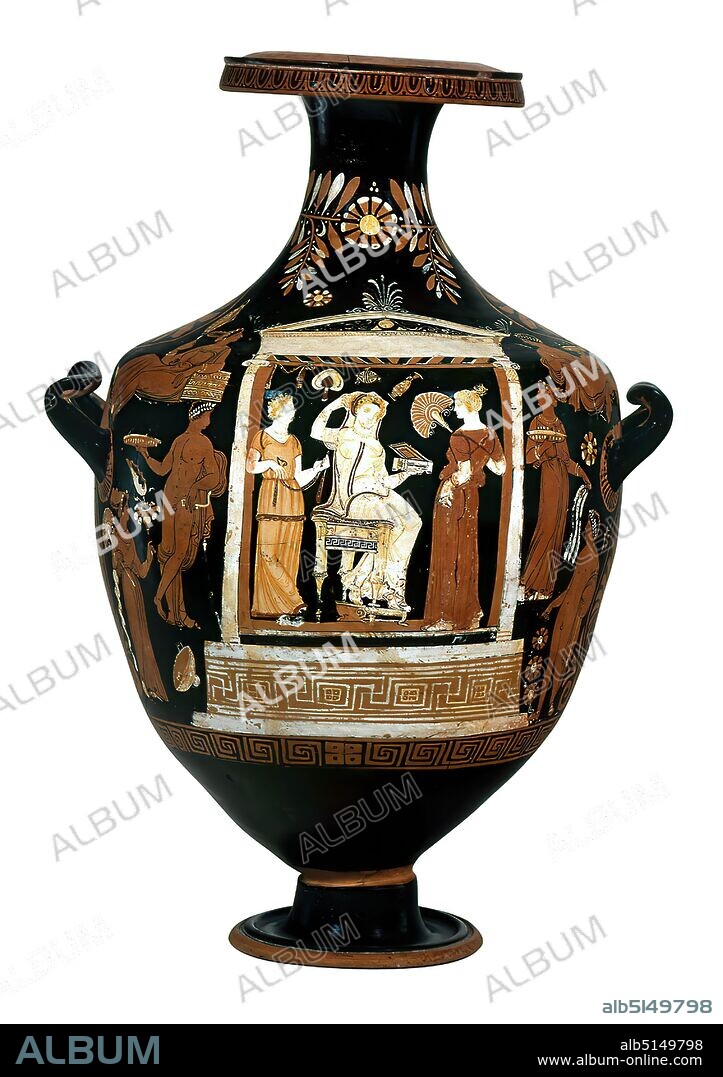alb5149798
Varrese-painter, Gioia del Colle-painter, Hydria (Naiskos scene), clay, quickly turned, painted (pottery), alternately fired, Total: Height: 74.2 cm (73.1-74.2); Diameter: 42.4 cm; Muzzle diameter: 24.2 cm; Diameter: 20.6 cm (foot); Diameter: 1 cm (handle holes), pottery, architecture, Late Classicism (Greek antiquity), The monumental Hydria was pottered in several parts; its individual parts are placed on top of each other at an angle. The richly painted vessel shows a naiskos with three persons on the front and three more figures on each side. The naiskos stands on a broad meandering base; its ceiling beams are depicted in perspective; on the flat gable there are three palmette macroteres. In the tomb, a woman sits on a richly decorated chair with a red blanket, her feet placed on a stool. With her right hand she holds the cloak laid over her head and in her left hand an open box. She is highlighted as the deceased by a white painting. To the left and right are two women, who, like the seated woman, are dressed in short-sleeved chitons in different colors. One holds a tänie, the other a fan in her hand. Spread over the open spaces are a fan, a tänie, a ball, a bandage and a lekythos. To the left of the naiskos there are two figures, a naked youth and a woman, above which another woman can be seen in a reclined position. On the right there is a similar group; the reclining woman is lying undressed on her coat. The back is covered with richly proliferating palmette ornaments, including a meandering cross-plate. At the neck olive branches with a rosette above the center of the picture. On the overhanging lip an ionic cymation. The fact that this vase was not intended for everyday use, but was intended as a burial object or for a libation, is proven by the missing floor inside. Through it, liquid donations could go directly to the earth deities. The dead is interpreted as the bride of the underworld gods in the hereafter. Such a characterization alludes to the Diony.

|
Zu einem anderen Lightbox hinzufügen |
|
Zu einem anderen Lightbox hinzufügen |



Haben Sie bereits ein Konto? Anmelden
Sie haben kein Konto? Registrieren
Dieses Bild kaufen
Untertitel:
Siehe automatische Übersetzung
Varrese-painter, Gioia del Colle-painter, Hydria (Naiskos scene), clay, quickly turned, painted (pottery), alternately fired, Total: Height: 74.2 cm (73.1-74.2); Diameter: 42.4 cm; Muzzle diameter: 24.2 cm; Diameter: 20.6 cm (foot); Diameter: 1 cm (handle holes), pottery, architecture, Late Classicism (Greek antiquity), The monumental Hydria was pottered in several parts; its individual parts are placed on top of each other at an angle. The richly painted vessel shows a naiskos with three persons on the front and three more figures on each side. The naiskos stands on a broad meandering base; its ceiling beams are depicted in perspective; on the flat gable there are three palmette macroteres. In the tomb, a woman sits on a richly decorated chair with a red blanket, her feet placed on a stool. With her right hand she holds the cloak laid over her head and in her left hand an open box. She is highlighted as the deceased by a white painting. To the left and right are two women, who, like the seated woman, are dressed in short-sleeved chitons in different colors. One holds a tänie, the other a fan in her hand. Spread over the open spaces are a fan, a tänie, a ball, a bandage and a lekythos. To the left of the naiskos there are two figures, a naked youth and a woman, above which another woman can be seen in a reclined position. On the right there is a similar group; the reclining woman is lying undressed on her coat. The back is covered with richly proliferating palmette ornaments, including a meandering cross-plate. At the neck olive branches with a rosette above the center of the picture. On the overhanging lip an ionic cymation. The fact that this vase was not intended for everyday use, but was intended as a burial object or for a libation, is proven by the missing floor inside. Through it, liquid donations could go directly to the earth deities. The dead is interpreted as the bride of the underworld gods in the hereafter. Such a characterization alludes to the Diony
Bildnachweis:
Album / quintlox
Freigaben (Releases):
Model: Nein - Eigentum: Nein
Rechtefragen?
Rechtefragen?
Bildgröße:
3049 x 4320 px | 37.7 MB
Druckgröße:
25.8 x 36.6 cm | 10.2 x 14.4 in (300 dpi)
Schlüsselwörter:
ARCHITEKTUR • BRAUT • DREI • EHE • EHEPAAR • EINFUSSER • EINFÜSSER • FRAU • FRAUEN • FUSS • GRAB • GRABBEIGABE • GRABMAL • GRABNISCHE • GRABSTAETTE • GRAEBER • GRUFT • GRUPPE • HAENDE • HAND • HÄNDE • KERAMIK • KOPF (ANATOMIE) • KOPF • LEKYTHOS • MANTEL • MAUSOLEUM • NAISKOS • PALETOT • SCHREIN • STEINGUT • TOD • TODESFALL • TOEPFEREI • TOEPFERWARE • TON • TUMBA • TÖPFEREI • TÜRBE • WEIBCHEN • WOMAN
 Pinterest
Pinterest Twitter
Twitter Facebook
Facebook Link kopieren
Link kopieren Email
Email
